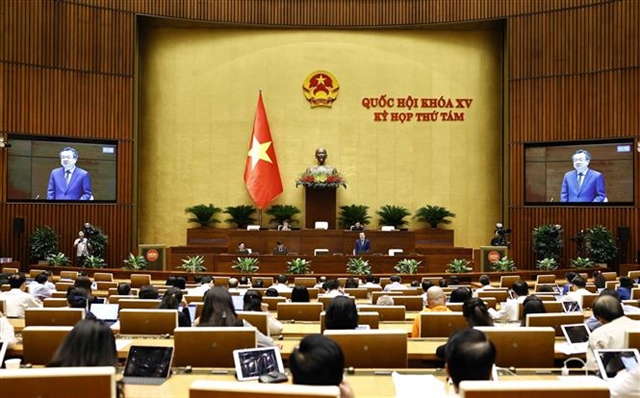 Politics & Law
Politics & Law

 |
| National Assembly deputies discuss on the draft Law on Urban and Rural Planning on Friday. VNA/VNS Photo |
HÀ NỘI – National Assembly deputies on Friday proposed that the group drafting a new Law on Urban and Rural Planning continue its research and revisions to ensure alignment and coherence, making it more adaptable to practical conditions.
The proposal was made during the eighth session of the 15th National Assembly, where a plenary session was held to discuss the draft legislation.
Presenting the report on the draft planning law, Vũ Hồng Thanh, Chairman of the National Assembly’s Economic Committee, noted that the revised and completed draft now consists of six chapters and 65 articles.
Emphasising the need to enact the Law on Urban and Rural Planning, Deputy Vi Đức Thọ from Sơn La Province highlighted that this law would provide a legal foundation and a comprehensive, consistent management tool for regulating urban and rural planning activities. This would address existing issues and limitations in practice, meet the country’s development requirements and enhance the effectiveness of state management.
Notably, the relationship between planning under the Urban and Rural Planning system and the National Planning system is explicitly defined in the 2017 Law on Planning. Article 6, Clause 4 of this law states that urban and rural planning must align with national, regional and provincial planning.
During the session, many NA deputies emphasised that urban and rural planning is a technical, specialised form of planning within the national planning system. However, there is still a lack of clear and specific regulations regarding the relationship between specialised, technical planning and other plans within the national system.
The deputies therefore agreed that careful consideration should be given to clarify how investment projects align with national, regional and provincial planning when reviewing investment policies, to avoid implementation obstacles.
At the session, Deputy Phạm Thị Thanh Mai from Hà Nội addressed the urban subdivision and detailed planning regulations. The draft law specifies that drawings illustrating urban subdivision plans should be scaled at 1 to 5,000 or 1 to 2,000. However, the 2023 Housing Law and the 2024 Land Law stipulate that one condition for selecting an investor for land-use projects is the availability of a detailed plan or a subdivision plan approved at a 1 to 2,000 scale.
Mai pointed out that cities with existing 1 to 5,000 scale subdivision plans would not be able to conduct investor selection under the Land Law. To ensure consistency between the Housing Law, Land Law and construction plans, Mai proposed adding a transitional clause to Article 65, allowing regions with 1 to 5,000 subdivision plans to proceed with investor selection. If necessary, these localities could adjust their plans to a 1 to 2,000 scale.
Similarly, Deputy Dương Khắc Mai from Đắk Nông Province offered insights on Article 36 regarding community consultation. Agreeing with the need for public input, he emphasised that consulting local communities on planning enhances transparency and thoroughness. However, as urban and rural planning is highly specialised with technical terms and complex drawings, many residents, especially in remote areas with lower levels of understanding, may struggle to fully grasp the content.
To foster effective planning and community agreement, Mai suggested that planning authorities should categorise content, simplify key issues and focus consultations on core topics like technical infrastructure, social facilities and housing. This approach would enable residents to provide meaningful input based on issues directly impacting their communities.
Reflecting on current planning challenges, Mai recommended that the draft law should harmonise various planning types such as mineral, land, regional and provincial planning to create robust development frameworks for localities, remove obstacles and address negative impacts on socio-economic growth.
This should include alignment with the Urban and Rural Planning Law and the proposed Geology and Minerals Law to ensure cohesive planning that drives development.
Additionally, NA deputies discussed topics like relationships between planning types, simultaneous planning principles, conflict resolution between urban and rural plans, planning for centrally governed cities, timeframes for planning, urban subdivision plans, general commune planning and transitional provisions for the approval and adjustment of urban and rural plans. – VNS